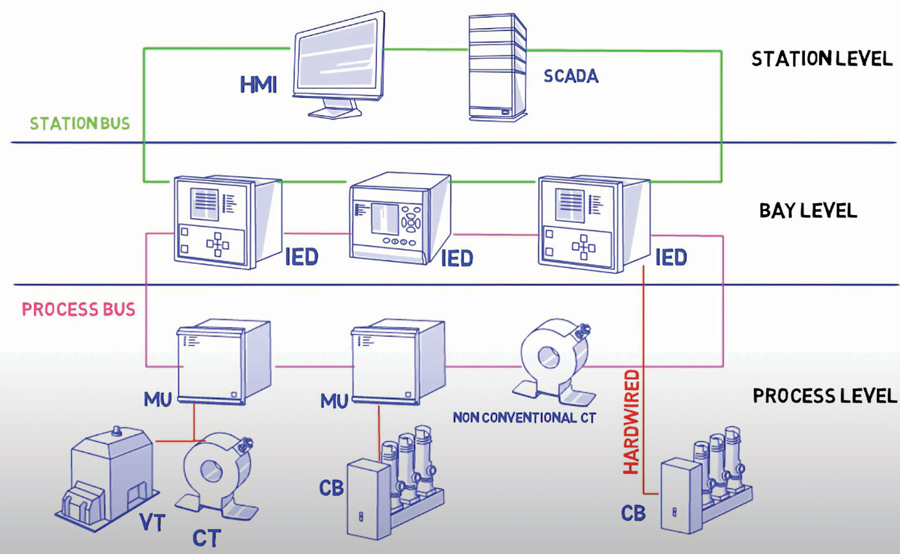Imagine attending a conference of the world’s leading scientists or engineers, all of them experts in their field, but communicating only in their native languages. While they may all be certified geniuses, their ability to work together to complete even simple tasks would be difficult, if not impossible. The power of each individual’s knowledge is vastly diminished due to the language barrier.
Until the early 2000s, the electrical industry faced the same challenge. Even as the need grew for a more secure and advanced electrical grid, the world was increasingly populated with smart devices that couldn’t easily communicate with one another.
WHAT IS IEC 61850?
The smart grid as we know it today is built on a foundation of effective communication and collaboration between devices. This crucial aspect of the smart grid is made possible by a communication standard known as IEC 61850, which was introduced by the International Electrotechnical Commission (IEC) in 2004. By establishing this standard, the IEC provided original equipment manufacturers (OEMs) with the flexibility to develop devices that seamlessly interact with one another and integrate into larger systems.
The primary objective behind the development of the standard was to establish a universal language and framework for communication within the power generation, distribution, and consumption ecosystem.
In essence, the implementation of IEC 61850 has revolutionized the smart grid by enabling devices to speak a common language and work together harmoniously. This standardized approach has facilitated the interoperability of various components, ensuring that power generation, delivery, and consumption systems can effectively communicate and cooperate with one another. Using the uniform language provided by the standard, OEMs have been able to design devices that effortlessly integrate into the smart grid, leading to enhanced efficiency, reliability, and scalability of power systems. By fostering a unified communication architecture, the protocol has significantly contributed to the advancement and widespread adoption of smart grid technologies.
IEC 61850 is a communication standard that defines some protocols like manufacturing message specification (MMS) and generic object-oriented substation event (GOOSE) messaging, but it’s much more than just a compilation of communication protocols. At the center of the standard is a way to model the substation — primary as well as secondary equipment — and define communications between devices and substations. The standard defines some of the engineering processes and methodologies that are used for substation automation. It also uses a modular approach to determine how to effectively expand and grow the system.
The original focus of the standard was on the power substation level and the communications between protective relays, equipment, and switchgear controls in order to provide interoperability between devices from various equipment vendors. It was so successful that the standard quickly evolved to encompass all network functions and domains (Figure 1), including hydro, wind, solar, and other distributed energy resources (DERs), transmission and distribution systems, and end-user facilities in every industry.

The standard encompasses a comprehensive set of communication protocols that establish the framework for data exchange between devices in the power system. These protocols utilize widely adopted technologies such as Ethernet and TCP/IP networks, enabling seamless communication between different devices and systems. By employing a common language for communication, the standard simplifies the integration of new components into the power system and facilitates the development of innovative applications and services.
In contrast to legacy communication architecture structures like Modbus, which rely on slower and less secure signal-oriented protocols, IEC 61850 introduced the more robust object-oriented protocol. This protocol offers a standardized approach to parallel communications, allowing devices to communicate with each other efficiently and effectively. The object-oriented protocol enhances the speed, reliability, and security of data transmission within the power system, enabling improved performance and resilience.
ADVANTAGES OF OBJECT-ORIENTED MODELING
The use of a common language and the adoption of an object-oriented modeling approach have provided significant advantages in terms of system integration and scalability. By adhering to the standard, different devices and systems can communicate seamlessly, regardless of their manufacturers or specific functionalities. This interoperability fosters flexibility and openness in the power system, facilitating the incorporation of new technologies and the expansion of the infrastructure.
The adoption of the object-oriented protocol within the standard not only enhanced communication efficiency and security but also brought about important benefits in terms of modularity and flexibility in the power system. By employing this protocol, the power system becomes more adaptable to changes and advancements without the need for extensive modifications to the existing infrastructure, allowing for the seamless integration of new devices or functionalities into the power system. With its modular nature, the standard allows new devices to be added or upgraded with relative ease, minimizing the associated costs and reducing disruptions to the overall power system.
By enabling modular expansion and simplified upgrades, the object-oriented protocol contributes to the overall resilience and scalability of the power system. It allows system operators to respond promptly to evolving demands, whether it involves integrating renewable energy sources, incorporating advanced monitoring and control functionalities, or adapting to changing regulatory requirements. This adaptability ensures that the power system remains efficient, reliable, and future-proof, supporting the needs of modern electricity grids.
GOOSE protocol is a communication model defined by the IEC 61850 standard. It serves as a fast, secure, and reliable mechanism for grouping data and transmitting it across communication networks. The design of GOOSE messages aligns with the objectives of the standard, which is to establish vendor independence. By eliminating vendor-specific requirements concerning equipment, configuration tools, cables, protocol modifications, and algorithms, the standard enables the creation of interoperable substation networks.
In addition to facilitating interoperability, the standard offers support for advanced functions within power systems. One such function is time synchronization, which ensures that devices across the system are precisely coordinated. This synchronization allows for accurate event logging and coordination of actions, enhancing the overall efficiency and reliability of the power system.
ENSURING SECURITY AND RESPONSIVENESS
Quality of service (QoS) management is another significant aspect of IEC 61850. It provides mechanisms to prioritize and allocate network resources effectively, guaranteeing that critical data is delivered in a timely and reliable manner. By ensuring appropriate QoS, the standard helps maintain the performance and responsiveness of the power system, even during periods of high network traffic or congestion.
Furthermore, the IEC standard places considerable emphasis on cybersecurity. As power systems become increasingly interconnected and digitized, protecting them from potential cyber threats becomes paramount. The standard incorporates security measures to safeguard data transmission and prevent unauthorized access or malicious manipulation of devices. By addressing cybersecurity concerns, IEC 61850 helps protect the integrity and resilience of the power system against potential cyber-attacks.
The support for advanced functions such as time synchronization, QoS management, and cybersecurity in IEC 61850 plays a vital role in ensuring the reliable and secure transmission of data between devices within the power system. These features contribute to maintaining the performance, reliability, and resilience of the power infrastructure, enabling it to meet the demands of modern power grids and effectively support critical services.
Overall, IEC 61850 is a critical standard for the modernization and optimization of power systems. By providing a common language and architecture for communication between devices, it enables the integration of new technologies and the development of advanced applications and services. This standard is increasingly important as the power system becomes more complex and distributed, and as new technologies such as renewable energy and electric vehicles are integrated into the grid.
IEC 61850 SYSTEM COMMISSIONING
Initially, testing or commissioning an electrical system that utilizes IEC 61850 communication protocols may appear intimidating and overwhelming to technicians. However, as they might do with any other electrical system encountered in the field, they can break down the overall installation into its fundamental components, which can greatly contribute to achieving success.
Adopting a step-by-step approach can be helpful, starting with a focus on the individual apparatus devices such as protective relays, breakers, and meters. Once the functionality of these devices is confirmed, attention can then be directed toward verifying the interoperability and communication paths within sub- or inter-systems, including aspects like cabling, switches, and routers.
To ensure the successful commissioning of an IEC 61850 system, it’s essential to divide the system into its three fundamental levels (Figure 2): the process level (PL), bay level (BL), and station level (SL).

Process Level
The process level is comprised of the elemental equipment, including switchgear, circuit breakers, switches, and instrument devices like current and voltage transformers. Testing of the apparatus equipment at this level follows conventional techniques and is guided by the specifications found in ANSI/NETA ATS and ANSI/NETA MTS.
Bay Level
Moving up to the bay level, the focus shifts toward validating the interoperability and communication paths within sub-systems. This involves testing the cabling, switches, routers, and other components that facilitate the communication and integration of the devices in the bay. The goal is to ensure that the communication paths are properly established and functional.
The bay level must also be thoroughly tested to ensure the signals being generated at the process level are received and processed correctly based on engineering design criteria. The bay level is where we find intelligent electronic devices (IEDs) that can receive and process information transmitted from the process level. A protective relay, for example, receives current and voltage input from instrument transformers or circuit breaker status (open/closed), all generated at the process level. Based on the programmed logic and settings, the protective relay completes a predetermined action or reporting task.
Bay-level commissioning includes protective relay testing, first ensuring all analog inputs (currents and voltage) and verifying the correct digital meter output. Trip elements used in the protection scheme are also tested to ensure the relay functions correctly and within tolerance guidelines, internal logic functions used in the protection scheme are tested, and lastly, the output contacts are verified to each controlled device.
During bay-level commissioning, it’s critically important to verify the interconnecting system of the process bus. The process bus is the communication system between IEDs and merging units (MUs) at the process level. This includes verifying the correct addressing and operation of devices, verifying the integrity of inter-cabling, and reviewing the installation of network equipment. This step is critical as any physical issues can impact the performance and reliability of the communication system to perform crucial protective actions as intended by the engineering design team.
IEDs receive input from apparatus equipment at the process level, but they also receive input from other IEDs at the bay level through the process bus. The communication and information transmitted from one IED to another can substantially increase the level of difficulty to properly commission the system, including zone selective interlocking (ZSI), reclosure, and breaker failure. ZSI, for example, may be activated from one IED and send blocking signals to another IED for an upstream circuit breaker. Not only does the initial fault condition need to be tested, but so must the blocking and redundant tripping of the upstream devices should a device tripping failure occur.
Station Level
Lastly, at the station level, the integrated system is examined and validated. This step requires a comprehensive understanding of the intended design of the protection scheme, as specified by the engineer of record (EOR). Technicians must verify that all subsystems are working together harmoniously and that the communication between different bays and stations is seamless and efficient.
The station level is where we find the human-machine interface (HMI) and supervisory control and data acquisition (SCADA) systems, which are used to control and monitor the overall system. In many real-world situations, this level is often the last phase ready for commissioning and brings the most attention to the commissioning team as it includes the front-facing equipment owners and operators have direct access to.
The commissioning of the station level involves several important tasks to ensure the proper functionality of the system. One crucial aspect is the simulation of inputs through IEDs and ensuring their seamless communication through the station bus. It is also essential to verify that the inputs are accurately displayed and represented in the SCADA or HMI system. Additionally, outputs from the station level, such as circuit breaker controls activated through the HMI, must be thoroughly checked for correct operation.
To successfully commission this level, the commissioning authority (CxA) must possess a solid understanding of the design intent provided by the EOR. This includes knowledge of the communication topography, device addressing or mapping, and the sequence of operations. This understanding is vital for effectively evaluating and troubleshooting the system during the commissioning process. In order to ensure a comprehensive commissioning, it is advisable to develop a method of procedure (MOP) that includes checklists to verify the proper registration of all inputs and the completion of all functional operations, whether initiated manually or through logic-driven means.
METHOD OF PROCEDURE
The MOP serves as a guide for technicians, enabling them to systematically validate the system’s performance. The checklists within the MOP help ensure that all inputs are correctly registered and that all required functional operations are executed as intended. By following the MOP and completing the checklists, technicians can identify any potential issues or inconsistencies in the system’s behavior, allowing for prompt resolution and optimization.
During the commissioning process, close attention should be paid to the communication flow, the accuracy of data representation, and the overall functionality of the system at the station level. This thorough evaluation ensures that the system operates reliably and that the communication between IEDs, station bus, and the SCADA or HMI system is functioning seamlessly.
By adhering to these commissioning practices and effectively utilizing the MOP and checklists, technicians can confidently commission the station level of the electrical system, ensuring that it performs optimally and meets the intended design specifications.
IEC 61850’s IMPACT ON THE ELECTRICAL INDUSTRY
IEC 61850 has greatly enhanced interoperability and integration among devices and systems within the electrical infrastructure. By providing a common language and standardized protocols, it enables seamless communication between various components, regardless of their manufacturer. This interoperability has simplified system integration, allowing for the efficient addition of new devices and functionalities without extensive modifications to the existing infrastructure.
Additionally, the standard has greatly improved the efficiency and flexibility of power system operations. IEC 61850 facilitates real-time monitoring, control, and automation of substations and power grids, enabling faster response to changing conditions and improved overall system performance. It has introduced advanced features like time synchronization, QoS management, and cybersecurity measures, ensuring reliable and secure data transmission between devices.
Furthermore, the adoption of IEC 61850 has led to significant cost savings and reduced maintenance efforts in the electrical industry. The protocol’s use of Ethernet and TCP/IP networks for communication eliminates the need for dedicated wiring and simplifies maintenance tasks. It also enables remote access and monitoring, reducing the need for on-site visits and improving troubleshooting capabilities.
CONCLUSION
Overall, the impact of the IEC standard on the electrical industry has been transformative. It has revolutionized communication and data exchange, improved system integration and interoperability, enhanced operational efficiency, facilitated renewable energy integration, reduced costs, and enabled the development of advanced applications. As the industry continues to evolve, the standard will play a crucial role in shaping the future of power systems.
Our responsibility as NETA Field Engineers and Technicians is to conduct comprehensive testing and commissioning of smart grid systems and the IEC 61850 installation. Our role validates the proper operation by testing each element of the smart grid system to verify its functionality and performance. This includes assessing the communication protocols, data exchange mechanisms, and interoperability between devices and systems. Throughout the testing and commissioning process, we maintain a meticulous approach to validate system settings and programmed logic. We perform thorough inspections, conduct functional tests, and analyze system behavior to ensure that all requirements are met.
Ultimately, our role is crucial in guaranteeing that smart grid systems and IEC 61850 designs are thoroughly tested and commissioned. Through our diligent efforts, we contribute to the successful implementation of these technologies, enabling reliable, efficient, and secure operation of modern power systems.

Matthew Wallace is Vice President of Field Services at CBS Field Services. A graduate of Iowa State University and the U.S. Navy Nuclear Program, he has more than 25 years of experience in the electrical testing and commissioning industry. Matthew is a NETA Certified Level 3 Technician.
